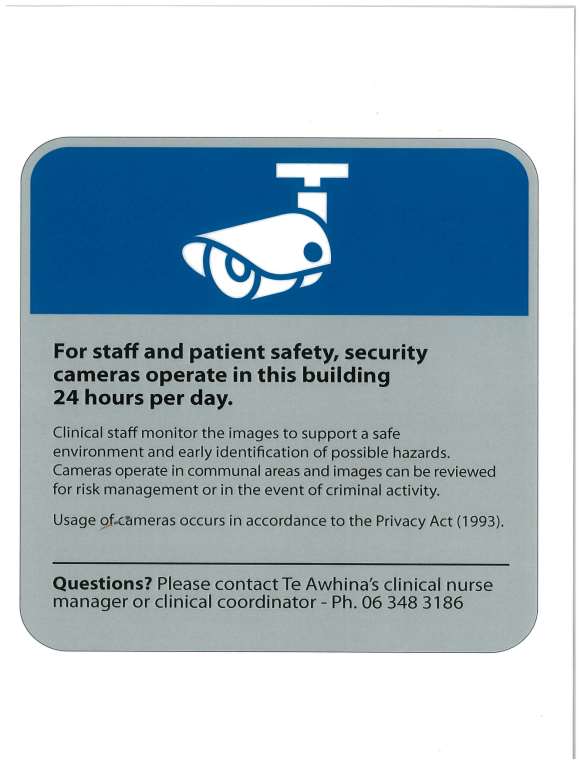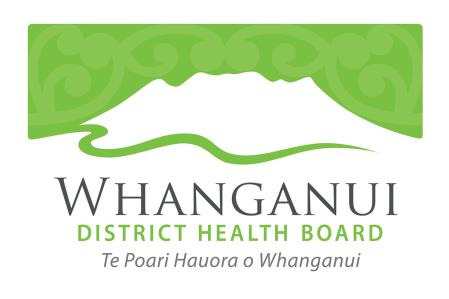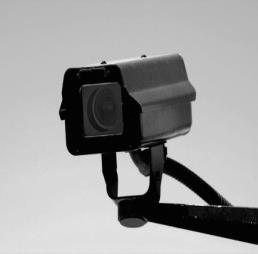

31 October 2017
Miss Black
via email: [FYI request #6620 email]
Dear Miss Black
Official Information Act Request –
Policy relating to security camera use in adult mental health inpatient unit
On 2 October 2017 under section 12 of the Official Information Act, you requested the fol owing
information from Whanganui District Health Board:
1. The reason/purpose for instal ing security cameras within your adult mental health inpatient
units. Especial y the reason/purpose for instal ing cameras in the three lounge areas.
2. How you measure that the security cameras are addressing their initial purpose (as listed in
answer to question 1.)
3. Al policy documents relating to the use of security cameras in adult mental health inpatient
units
Whanganui District Health Board's response:
The reason/purpose for installing security cameras within you adult mental health
inpatient units. Especially the reason/purpose for installing cameras in the three lounge
areas.
The reason/purpose for instal ing security cameras within Te Awhina was to create a safe environment
for staff, service users/tangata whaiora and visitors to the unit. It is also in place to protect property
and to early identify any possible hazards.
We acknowledge that CCTV systems cannot replace clinical care and are by no means the answer to all
security concerns. They can, nonetheless, offer a potential medium by which personnel can enhance
levels of care and security.
With regards to undertaking close observations, these must be physically undertaken and CCTV is not
relied on. This is stressed through orientation and ongoing education with staff. There have been no
issues related to staff being over reliant on CCTV since its installation.
Chief Executive |
Phone 06 348 3140 |
Fax 06 345 9390
 How you measure that the security cameras are addressing their initial purpose (as listed
in answer to question 1.)
How you measure that the security cameras are addressing their initial purpose (as listed
in answer to question 1.)
It was difficult to create a standard as CCTV was installed in Te Awhina at the same time as the
refurbished facility was opened. Models of care changed and different incident reporting thresholds
established.
However, the reduced reporting of theft, serious assaults, damage to property is an important measure
for the service. While such incidents have occurred, accountability has been able to be assigned to these
incidents.
No complaints have been received with regard to the CCTV being instal ed and we would consider this
an important measure.
All policy documents relating to the use of security cameras in adult mental health
inpatient units
A copy of the fol owing policies are attached:
Closed Circuit Television (CCTV) in Te Awhina Policy
Stanford House Closed Circuit Television (CCTV) Policy
I trust this information wil satisfy your request, if you have any further queries, please contact our OIA
coordinator in the first instance:
shonel [email address]
Please attruibute this information to Mr Jeff Hammond, Associate Director of Nursing – Mental
Health/DAMHS.
Yours sincerely
Brian Walden
Acting Chief Executive Officer

Policy
Mental Health and Addiction Services
Closed Circuit Television (CCTV) Policy in Te Awhina Policy
Applicable To: Mental Health Inpatient staff,
Authorised By: Nurse Manager, Mental Health &
Whanganui District Health Board
Addiction Services
Contact Person: Director of Area Mental Health
Services (DAMHS)
1. Purpose
This policy has been prepared to ensure that the closed circuit television (CCTV) system at Te Awhina
is used in the way it is intended; that is to create a safe environment for staff, service users/tangata
whaiora and visitors to the unit to protect property and to identify early any possible hazards. It is
also in place to ensure its operation is consistent with requirements under the Privacy Act (1993).
2.
Scope
This policy applies to al Whanganui District Health Board (WDHB) employees (permanent, temporary
and casual), visiting medical officers, and other partners in care, contractors, consultants and
volunteers who are able to view footage of the CCTV images.
3.
Prerequisites
CCTV systems cannot replace clinical care and are by no means the answer to all security concerns;
they can, nonetheless, offer a potential medium by which personnel can enhance levels of care and
security.
With regards to undertaking close observations, these must be physical y undertaken and CCTV not
relied on.
4.
Definitions
CCTV: Closed circuit television.
Communal areas: Public areas including foyer areas, waiting rooms and egress points.
Staff work areas: CCTV wil be used in staff work areas where the safety/security of staff or the
protection of assets is believed to justify this. This area includes locations that have critical
equipment, IT equipment, stores, key records etc.
Private areas: These are areas where any individual would reasonably expect privacy. This includes
toilet and ablution areas, and bedrooms. There wil be no CCTV monitoring of these areas.
Document number: WDHB-6071
Page 1 of 4
Version number:3
Date authorised: 31/03/2017
Next review date: 31/03/2020
Whanganui District Health Board control ed document. The electronic version is the most up-to-date version. WDHB wil
not take responsibility in the event of an outdated paper copy being used which may lead to an undesirable consequence.
5.
Roles and responsibilities
Clinical Nurse Manager:
to ensure that the purposes and objectives of the system are not exceeded
to notify al persons including staff, service users/tangata whaiora, their families and other
visitors of where CCTV is installed and that a CCTV system is in operation
to facilitate formal subject access requests of any images captured under the terms of the Health
Privacy Code 1994
to provide copies of this policy when required to do so
to ensure that there is appropriate signage to inform people entering and leaving buildings/car
parking that CCTV is in place
to ensure TV screens cannot be seen by individuals who are not authorised to do so.
Clinical staff:
to comply with this policy
to provide information to service users/tangata whaiora and family/whanau
to monitor images
to report issues of faults to clinical nurse manager.
Facilitator, Facilities Services and Projects:
manage audit of CCTV equipment
responsible for storage and disposal of images
liaison with security personnel as required.
6.
Policy
Service users/tangata whaiora are advised of the system and the functions it provides.
Cameras wil not be hidden from view and appropriate steps must be taken eg. by signage and
displaying posters, to inform the public of the presence of the system. This signage should also
include an image/picture of a camera as additional information.
No CCTV camera is to be placed in private areas where the privacy and dignity of a service
user/tangata whaiora may be compromised. This includes toilet and ablution areas, bedrooms,
dormitories or similar.
In the case of individual high dependency or vulnerable service users/tangata whaiora, a CCTV
monitor maybe installed after discussion with the clinical director and the director of area mental
health services.
For safety and security of service users/tangata whaiora, staff and visitors, CCTV wil be placed in
communal areas, corridors and egress points.
Images which are not required for the purpose(s) for which the equipment is being used, should
not be retained for longer than is necessary. While images are retained, it is essential that their
integrity be maintained, whether it is to ensure their evidential value or to protect the rights of
people whose images may have been recorded. It is therefore important that access to and
security of the images is control ed in accordance with the requirements of the Health Privacy
Code 1994.
Monitors wil be located in the Te Awhina nursing station and wil be only accessible to WDHB
employees (permanent, temporary and casual), visiting medical officers, and other partners in
care, contractors, consultants and volunteers who have reason to be there.
Training/support
Ensure all staff have access to the policy.
Provide basic information/training in the system for al staff who may need to explain the CCTV
system to service users/tangata whaiora, their families/whanau and other visitors.
Ensure staff are aware of the need to protect people’s privacy and the consequence of any
breach (eg. disciplinary action for unjustifiably accessing or using information).
Document number: WDHB-6071 Page 2 of 4 Version number: 3
Use of CCTV footage:
Security personnel in conjunction with the
facilitator, facilities services and projects may supply
NZ Police with downloaded stil s and footage from CCTV if required to do so in order to assist in
the identification of alleged offenders to criminal events. A record of such request wil be kept. A
Police Request Access/Disclosure Form is to be completed by Police before data wil be released.
Where it is decided by the security manager in conjunction with the
facilitator, facilities services
and projects that the assistance of Te Awhina staff is needed to identify a victim or perpetrator in
relation to a criminal incident, images from the system may be circulated via the organisation’s
email system to selected staff. As part of this decision, the wishes of the victim of an incident
wil wherever possible be taken into account.
7.
Measurement criteria
Regular audits wil occur of equipment and procedures to ensure the system is operating
smoothly.
Check that staff are complying with policies and retrain as required.
8.
References
Privacy and CCTV: A guide to the Privacy Act for businesses, agencies and organisations.
Privacy Commissioner Te Mana Matapono Matatapu
9.
Related WDHB documents
Te Awhina Operational Policy
Whanganui District Health Board Information Communication and Technology Security Policy
Whanganui District Health Board Confidentiality Policy
Whanganui District Health Board Code of Conduct Policy
10. Appendix
Appendix one: Information poster
11. Key words
CCTV, Te Awhina, closed circuit TV, television, camera, images, footage
Document number: WDHB-6071 Page 3 of 4 Version number: 3
 Appendix I: Information Poster
Appendix I: Information Poster
Document number: WDHB-6071 Page 4 of 4 Version number: 3

Policy
Stanford House Closed Circuit Television (CCTV) Policy
Applicable to:
Authorised by: Nurse Manager, Mental Health and
Mental Health Inpatient staff
Addiction Services
Whanganui District Health Board
Contact person: Clinical
Nurse Manager, Stanford
House Extended Secure Regional Forensic Service
1. Purpose
This policy has been prepared to ensure that the closed circuit television (CCTV) system at Stanford
House is used in the way it is intended; that is to create a safe environment for staff, service
users/tangata whaiora and visitors to the unit to protect property and to identify early any possible
hazards. It is also in place to ensure its operation is consistent with requirements under the Privacy
Act (1993).
2.
Scope
This policy applies to al Whanganui District Health Board (WDHB) employees (permanent, temporary
and casual), visiting medical officers, and other partners in care, contractors, consultants and
volunteers who are able to view footage of the CCTV images.
3.
Prerequisites
CCTV systems cannot replace clinical care and are by no means the answer to all security concerns;
they can, nonetheless, offer a potential medium by which personnel can enhance levels of care and
security.
With no regards to undertaking close observations, these must be physical y undertaken and CCTV not
relied on.
4.
Definitions
CCTV - Closed circuit television
Communal areas - Public areas including foyer areas, waiting rooms and egress points
Staff work areas - CCTV wil be used in staff work areas where the safety/security of staff or the
protection of assets is believed to justify this. This area includes locations that have critical
equipment, IT equipment, stores, key records etc.
Private areas - These are areas where any individual would reasonably expect privacy. This includes
toilet and ablution areas and bedrooms. There wil be no CCTV monitoring of these areas.
Document number: WDHB-6713
Page 1 of 4
Version number: 2
Date authorised:19/10/2015
Next review date:19/10/2017
Whanganui District Health Board control ed document. The electronic version is the most up-to-date version. WDHB wil
not take responsibility in the event of an outdated paper copy being used which may lead to an undesirable consequence.
5.
Policy
Service users/tangata whaiora are advised of the system and the functions it provides.
Cameras wil not be hidden from view and appropriate steps must be taken eg by signage and
displaying posters, to inform the public of the presence of the system. This signage should also
include an image/picture of a camera as additional information.
No CCTV camera is to be placed in private areas where the privacy and dignity of a service
user/tangata whaiora may be compromised. This includes toilet and ablution areas, bedrooms,
dormitories or similar.
In the case of individual high dependency or vulnerable service users/tangata whaiora, a CCTV
monitor may be installed after discussion with the clinical director and the director of area
mental health services.
For safety and security of service users/tangata whaiora, staff and visitors, CCTV wil be placed
in areas where service users/tangata whaiora are involved in activities that can not be directly
observed. Also in areas where service users/tangata whaiora are able to access without
supervision/attendance of staff.
Images which are not required for the purpose(s) for which the equipment is being used,
should not be retained for longer than is necessary. While images are retained, it is essential
that their integrity be maintained, whether it is to ensure their evidential value or to protect the
rights of people whose images may have been recorded. It is therefore important that access
to and security of the images is control ed in accordance with the requirements of the Health
Privacy Code 1994.
Monitors wil be located in the Stanford House nursing station and wil be only accessible to
WDHB employees (permanent, temporary and casual), visiting medical officers, and other
partners in care, contractors, consultants and volunteers who have reason to be there.
Training/support
Ensure all staff have access to the policy.
Provide basic information/training in the system for all staff who may need to explain the CCTV
system to service users/tangata whaiora, their families/whanau and other visitors.
Ensure staff are aware of the need to protect people’s privacy and the consequence of any
breach (eg disciplinary action for unjustifiably accessing or using information).
Use of CCTV footage
Security personnel in conjunction with the facilitator, facilities services and projects may supply
NZ Police with downloaded stil s and footage from CCTV if required to do so in order to assist in
the identification of alleged offenders to criminal events. A record of such request wil be kept.
A Police Request Access/disclosure Form is to be completed by Police before data wil be
released.
Where it is decided by the security manager in conjunction with the facilitator, facilities services
and projects that the assistance of Stanford House staff is needed to identify a victim or
perpetrator in relation to a criminal incident, images from the system may be circulated via the
organisation’s email system to selected staff. As part of this decision, the wishes of the victim
of an incident wil wherever possible be taken into account.
6.
Roles and responsibilities
Clinical nurse manager:
to ensure that the purposes and objectives of the system are not exceeded
to notify al persons including staff, service users/tangata whaiora, their families and other
visitors of where CCTV is installed and that a CCTV system is in operation
to facilitate formal subject access requests of any images captured under the terms of the
Health Privacy Code 1994
to provide copies of this policy when required to do so
to ensure that there is appropriate signage to inform people entering and leaving buildings/car
parking that CCTV is in place
to ensure TV screens cannot be seen by individuals who are not authorised to do so
Document number: WDHB-6713
Page 2 of 4
Version number:2
manage audit of CCTV equipment.
Clinical staff:
to comply with this policy
to provide information to service users/tangata whaiora and family/whanau
to monitor images
to report issues of faults to clinical nurse manager.
Facilitator, Facilities Services and Projects:
responsible for storage and disposal of images
liaison with security personnel as required.
7.
Measurement criteria
Regular audits wil occur of equipment and procedures to ensure the system is operating
smoothly.
Check that staff are complying with policies and retrain as required.
8.
References
Privacy and CCTV: A guide to the Privacy Act for businesses, agencies and organisations.
Privacy Commissioner Te Mana Matapono Matatapu
9.
Related Whanganui District Health Board documents
Stanford House Operational Policy
Whanganui District Health Board Information Communication and Technology Security Policy
Whanganui District Health Board Confidentiality Policy
Whanganui District Health Board Code of Conduct Policy
10. Appendix
Appendix one: Information poster
11. Key words
CCTV, Stanford House, closed circuit TV, television, camera, images, footage
Document number: WDHB-6713
Page 3 of 4
Version number:2
 Appendix 1: Information Poster
Appendix 1: Information Poster
For staff and patient safety, security cameras
operate in this building 24 hours per day
Clinical staff monitor the images to support a safe environment
and early identification of possible hazards. Cameras operate in
communal areas and images can be reviewed for risk
management or in the event of criminal activity.
Usage of cameras occurs in accordance with the Privacy Act
(1993)
Questions? Please contact Stanford House’s clinical nurse
manager – ph 06 348 3342
Document number: WDHB-6713
Page 4 of 4
Version number:2
Document Outline






